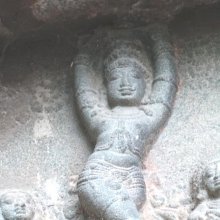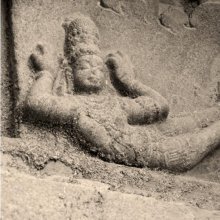Vivartita: 8 definitions
Introduction:
Vivartita means something in Hinduism, Sanskrit. If you want to know the exact meaning, history, etymology or English translation of this term then check out the descriptions on this page. Add your comment or reference to a book if you want to contribute to this summary article.
Images (photo gallery)
In Hinduism
Ayurveda (science of life)
Source: archive.org: Sushruta samhita, Volume IIPain and unevenness of the joint owing to the displacement of the connected bones distinguish a case of Vivartitam (lateral displacement)

Āyurveda (आयुर्वेद, ayurveda) is a branch of Indian science dealing with medicine, herbalism, taxology, anatomy, surgery, alchemy and related topics. Traditional practice of Āyurveda in ancient India dates back to at least the first millenium BC. Literature is commonly written in Sanskrit using various poetic metres.
Natyashastra (theatrics and dramaturgy)
Source: Wisdom Library: Nāṭya-śāstra1) Vivartita (विवर्तित, “raising up”) refers to a specific gesture (āṅgika) made with the eyelids (puṭa), according to the Nāṭyaśāstra chapter 8. These gestures of the eyelids (puṭa) are supposed to follow the corresponding movements of the eyeballs (tārā). These gestures form a part of the histrionic representation (abhinaya).
2) Vivartita (विवर्तित, “turned round”) refers to a specific gesture (āṅgika) made with the sides (pārśva), according to the Nāṭyaśāstra chapter 10. The sides are one of the six major limbs (aṅga) used to perform certain gestures (āṅgika). These gestures form a part of the histrionic representation (abhinaya).
3) Vivartita (विवर्तित) also refers to a type of lying-down posture (śayana); it is a Sanskrit technical term defined in the Nāṭyaśāstra chapter 12.
Source: archive.org: Natya Shastra1) Vivartita (विवर्तित, “raising up”).—A type of gesture (āṅgika) made with the eyelids (puṭa);—Instructions: raising up the eyelids. Uses: in anger (krodha).
2) Vivartita (विवर्तित, “turned round”).—A type of gesture (āṅgika) made with the sides (pārśva);—(Instructions): The Trika (sacrum) is to be turned round.(Uses): In turning about.
3) Vivartita (विवर्तित).—A type of lying-down posture (śayana).—Instructions:Lying down with the face downwards is called the Vivartita posture. It is to be assumed in [repre-senting] wound from any weapon, death, vomiting, intoxication and lunacy.
Source: Shodhganga: Elements of Art and Architecture in the Trtiyakhanda of the Visnudharmottarapurana (natya)1) Vivartita (विवर्तित) refers to one of the “five kinds of side-movements” (in Sanskrit Dramas), as conveyed through Āṅgikābhinaya: one of the four divisions of Abhinaya or “ways to convey or represent one’s emotion to others”, according to the Viṣṇudharmottarapurāṇa, an ancient Sanskrit text which (being encyclopedic in nature) deals with a variety of cultural topics such as arts, architecture, music, grammar and astronomy.—The āṅgikābhinaya includes the histrionic representation of the limbs which is simply known as physical gestures. There are five kinds of side movements accepted in the Viṣṇudharmottarapurāṇa. The vivartita movement refers to circular movement.
2) Vivartita (विवर्तित) refers to one of the nine kinds of śayyāsthāna or “lying down postures”.—In the Viṣṇudharmottarapurāṇa, nine kinds of upaveśana i.e., sitting postures are accepted for Drama. Some particular postures are recommended in the Viṣṇudharmottarapurāṇa as śayyāsthāna, which are adopted by the actors at time of lying down in a Drama. In the vivartita position, the actor should bring his face down to show that the person is hit by weapon or he is acting the role of a dead or a drunken person
3) Vivartita (विवर्तित) refers to one of the 108 kinds of Karaṇa (“coordination of precise movements of legs and hands”), according to the Viṣṇudharmottarapurāṇa.—Accordingly, karaṇas are the coordination of precise movements of legs and hands performed in a particular posture. The Nāṭyaśāstra also gives its view point in the same spirit. In the Viṣṇudharmottarapurāṇa, one hundred and eight kinds of karaṇas are accepted, e.g., Vivartita.

Natyashastra (नाट्यशास्त्र, nāṭyaśāstra) refers to both the ancient Indian tradition (shastra) of performing arts, (natya—theatrics, drama, dance, music), as well as the name of a Sanskrit work dealing with these subjects. It also teaches the rules for composing Dramatic plays (nataka), construction and performance of Theater, and Poetic works (kavya).
Purana and Itihasa (epic history)
Source: archive.org: Shiva Purana - English TranslationVivartita (विवर्तित) refers to “being tossed about” (in a stormy whirlwind), according to the Śivapurāṇa 2.5.16 (“The battle of the gods”).—Accordingly, after Viṣṇu spoke to Lakṣmī: “[...] Then the Daityas afflicted by the gusts of wind set in motion by the wings in the speedy flight of the younger brother of Aruṇa (i.e Garuḍa) were blown here and there like the clouds in the sky tossed about in a stormy whirlwind (vātyā-vivartita). Then on seeing the Asuras afflicted by the gusts of wind, Jalandhara rushed against Viṣṇu shouting out cries of bravery angrily. [...]”.

The Purana (पुराण, purāṇas) refers to Sanskrit literature preserving ancient India’s vast cultural history, including historical legends, religious ceremonies, various arts and sciences. The eighteen mahapuranas total over 400,000 shlokas (metrical couplets) and date to at least several centuries BCE.
Languages of India and abroad
Sanskrit dictionary
Source: DDSA: The practical Sanskrit-English dictionaryVivartita (विवर्तित).—p. p.
1) Turned or whirled round, revolved.
2) Moved round or about, rolling; विवर्तितभ्रूरियमद्य शिक्षते (vivartitabhrūriyamadya śikṣate) Ś.1.23.
3) Mangled, hacked, cut to pieces; संसक्त- त्रुटितविवर्तितान्त्रजाल (saṃsakta- truṭitavivartitāntrajāla) ... Mālatīmādhava (Bombay) 3.17.
5) Unfolded.
6) Distorted, bent down.
Source: Cologne Digital Sanskrit Dictionaries: Monier-Williams Sanskrit-English Dictionary1) Vivartita (विवर्तित):—[=vi-vartita] [from vi-varta > vi-vṛt] mfn. ([from] [Causal]) turned round etc., [Mahābhārata; Kāvya literature] etc.
2) [v.s. ...] turned away or back, averted, [Kumāra-sambhava]
3) [v.s. ...] distorted, [Suśruta]
4) [v.s. ...] knitted (as the brows), [Śakuntalā]
5) [v.s. ...] whirled round (as dust), [Kirātārjunīya]
6) [v.s. ...] removed from one’s place, [Śiśupāla-vadha]
Sanskrit, also spelled संस्कृतम् (saṃskṛtam), is an ancient language of India commonly seen as the grandmother of the Indo-European language family (even English!). Closely allied with Prakrit and Pali, Sanskrit is more exhaustive in both grammar and terms and has the most extensive collection of literature in the world, greatly surpassing its sister-languages Greek and Latin.
Kannada-English dictionary
Source: Alar: Kannada-English corpusVivartita (ವಿವರ್ತಿತ):—[adjective] turned aside; rolled over or onward.
--- OR ---
Vivartita (ವಿವರ್ತಿತ):—
1) [noun] (dance.) a turning of the flank and the hips round.
2) [noun] the turning of the eye-balls.
Kannada is a Dravidian language (as opposed to the Indo-European language family) mainly spoken in the southwestern region of India.
See also (Relevant definitions)
Starts with: Vivartitaka.
Ends with: Avivartita, Suvivartita, Vatyavivartita.
Full-text: Suvivartita, Parshva, Sandhi-mukta, Apasrita, Sayana, Circular, Vivarta, Dead person, Vivart, Drunken person, Shayyasthana, Side, Puta, Vatya, Vrit.
Relevant text
Search found 6 books and stories containing Vivartita, Vi-vartita; (plurals include: Vivartitas, vartitas). You can also click to the full overview containing English textual excerpts. Below are direct links for the most relevant articles:
The Garuda Purana (by Manmatha Nath Dutt)
Chapter CXCI - The Nidanam of fractures < [Dhanvantari Samhita]
Sahitya-kaumudi by Baladeva Vidyabhushana (by Gaurapada Dāsa)
Text 8.26 < [Chapter 8 - Literary Qualities]
Natyashastra (English) (by Bharata-muni)
Chapter X - Gestures of other Limbs
Chapter VIII - Gestures of Minor Limbs (upāṅga)
Vishnudharmottara Purana (Art and Architecture) (by Bhagyashree Sarma)
2.5. Karaṇa (movements of legs and hands) < [Chapter 3 - Drama and Dance]
1.3. Elements of Drama (d): Dramatic Postures < [Chapter 3 - Drama and Dance]
1.3. Elements of Drama (c): Bodily Movements < [Chapter 3 - Drama and Dance]
Sushruta Samhita, volume 2: Nidanasthana (by Kaviraj Kunja Lal Bhishagratna)
Gati in Theory and Practice (by Dr. Sujatha Mohan)
Gati used for the delineation of Bhāva and Rasa < [Chapter 3 - Application of gati in Dṛśya-kāvyas]

